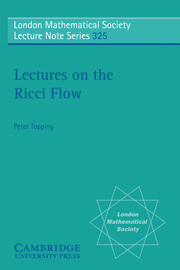Book contents
- Frontmatter
- Contents
- Preface
- 1 Introduction
- 2 Riemannian geometry background
- 3 The maximum principle
- 4 Comments on existence theory for parabolic PDE
- 5 Existence theory for the Ricci flow
- 6 Ricci flow as a gradient flow
- 7 Compactness of Riemannian manifolds and flows
- 8 Perelman's W entropy functional
- 9 Curvature pinching and preserved curvature properties under Ricci flow
- 10 Three–manifolds with positive Ricci curvature, and beyond
- A Connected sum
- References
- Index
7 - Compactness of Riemannian manifolds and flows
Published online by Cambridge University Press: 03 May 2010
- Frontmatter
- Contents
- Preface
- 1 Introduction
- 2 Riemannian geometry background
- 3 The maximum principle
- 4 Comments on existence theory for parabolic PDE
- 5 Existence theory for the Ricci flow
- 6 Ricci flow as a gradient flow
- 7 Compactness of Riemannian manifolds and flows
- 8 Perelman's W entropy functional
- 9 Curvature pinching and preserved curvature properties under Ricci flow
- 10 Three–manifolds with positive Ricci curvature, and beyond
- A Connected sum
- References
- Index
Summary
Having shown in Section 5.3 that the curvature of a Ricci flow must blow up in magnitude at a singularity, we will now work towards a theory of ‘blowing–up’ whereby we rescale a flow more and more as we get closer and closer to a singularity, and hope that if we rescale by enough to keep the curvature under control, then we can pass to a limit of flows to give a Ricci flow which captures some of what is happening at the singularity. Refer back to Section 1.2.3 for a discussion of rescaling.
The first step in this direction is to pin down what it means for a sequence of flows, or indeed of manifolds, to converge. We then need some sort of compactness theorem to allow us to pass to a limit.
We will not give the rather long proofs of these compactness results, but refer the reader to.
Convergence and compactness of manifolds
It is reasonable to suggest that a sequence {gi} of Riemannian metrics on a manifold ℳ should converge to a metric g when gi → g as tensors. However, we would like a notion of convergence of Riemannian manifolds which is diffeomorphism invariant: it should not be affected if we modify each metric gi by an i–dependent diffeomorphism. Once we have asked for such invariance, it is necessary to discuss convergence with respect to a point of reference on each manifold.
- Type
- Chapter
- Information
- Lectures on the Ricci Flow , pp. 65 - 70Publisher: Cambridge University PressPrint publication year: 2006



